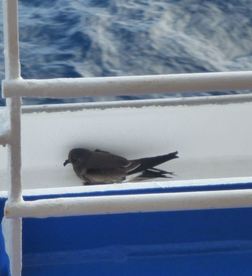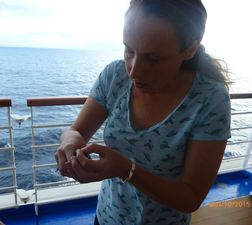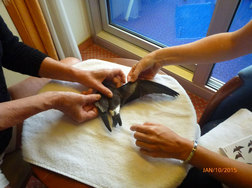WildCare's Wildlife Hospital treats nearly 4,000 ill, injured and orphaned wild animal patients from over 200 species every year. This is one patient's story.
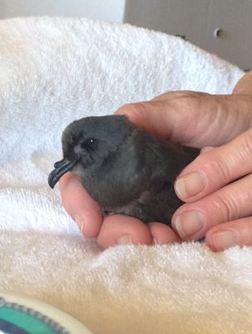
This Leach's Storm Petrel was very lucky that WildCare personnel happened to be on board a cruise ship to Mexico the day he struck a window. He was even luckier that WildCare Ambassador Program Manager, Mary Pounder was walking the Promenade Deck at the time it happened.
A crewmember had already spotted the bird as Mary approached, and as she leaned down to investigate, the crewmember shouted "Don't touch it! It could make you sick!"
Mary, knowing that there is nothing at all a human can contract from touching the feathers of a bird, reassured the crewmember that she worked for WildCare, a licensed wildlife rescue center, and that she knew what she was doing.
Meanwhile Mary's husband David was calling the room of WildCare Director of Animal Care, Melanie Piazza, also on the cruise, to come do what she does best -- save a wild animal's life!
The ship's crew member had alerted the on-board Environmental Officer, who arrived at the scene at the same time Melanie did. Apparently it's not uncommon for birds to strike cruise ships -- towering skyscrapers traveling at 21 knots that they are! At a loss as to what to do for them, crew members will usually place these fish-eating unfortunates in a box with some bread (!) to hopefully recover on their own. Most outcomes are poor.
So this ship's Environmental Officer was thrilled to have actual wildlife medical experts on board. After clearing it with the ship's bridge, he gave permission to Melanie and Mary to take charge of the bird's care.
A window-struck bird will be in shock. He'll probably have head trauma, and possibly broken bones. Subcutaneous fluids are one of the first treatments for shock so, after gently tucking the bird into a bag, the Environmental Officer and rescuers walked to the Medical Bay where Melanie asked for and received syringes and saline hydrating solution.
Then they brought the bird to Mary's cabin, and turned up the heat to help warm him while Melanie performed a gentle exam.
Without a radiograph machine, determining if bones are broken on a bird the size of a robin is a real challenge, but Melanie is an expert. Mary held the bird while Melanie gently palpated the bones of the wings, spine and legs. To her relief, no fractures presented. They knew the bird had hit his head-- a small patch of feathers over his right eye was disrupted, and the eye was swollen shut. Such a head injury can be very serious, but with luck this bird could recover.
Melanie rehydrated the bird with subcutaneous fluids, and found an ingenious method to provide him with a heat source while he recovered. She borrowed two stones from the Hot Stone Massage room in the ship's luxurious spa! These stones are known to retain heat, so a few minutes in hot water kept them warm for a long time. Melanie tucked the stones into a wash cloth and placed them in the box with the bird. Now rehydrated and warm, the bird had a much better chance at recovering from his ordeal.
 Meanwhile, Melanie knew that the bird would be with them for a few days, and he'd need to eat during that time. A pelagic bird like a Storm Petrel isn't going to eat bread, obviously. He needed fish. A request for an interview with the ship's head chef quickly resulted in a fresh piece of raw fish from the kitchen. Cruise ships are astonishingly accommodating!
Meanwhile, Melanie knew that the bird would be with them for a few days, and he'd need to eat during that time. A pelagic bird like a Storm Petrel isn't going to eat bread, obviously. He needed fish. A request for an interview with the ship's head chef quickly resulted in a fresh piece of raw fish from the kitchen. Cruise ships are astonishingly accommodating!
The bird in his box spent the night in the cabin bathroom, and the next day Melanie and Mary decided to reexamine him, try to feed him and offer him the chance to swim, preen and repair his waterproofing.

Back into his box with the warmed stones he went. He hadn't yet recovered, but Mary and Melanie were pleased to see him more alert and responsive than he had been the day before.
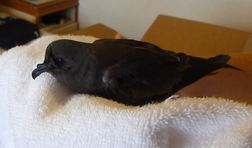
On the second toss, this little bird flew beautifully within the cramped confines of the cruise ship cabin. With big smiles of relief, Melanie and Mary proclaimed him ready to be released.
After checking the wind speed across the decks, the group trooped down to the port side of the aft Promenade Deck. There was no possibility of the ship's being slowed down for the release, so they knew, between the winds and the ship's speed, the first few moments of the bird's flight could be fairly chaotic. The rear of the ship made the most sense for the release, and the port side offered the best protection from the wind.
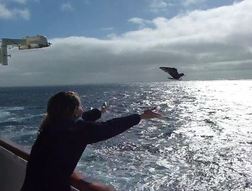
Watch the bird's release in the video below.
WildCare is a 501(c)3 nonprofit organization supported almost entirely by private donations and individual memberships. Visit us online at wildcarebayarea.org.

